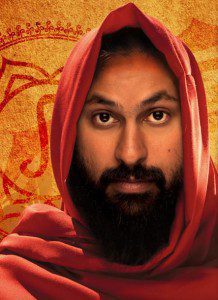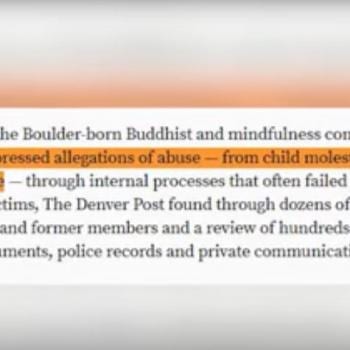
Kumare, or Kumaré (or Kūmāré), is a movie about American spirituality on the fringe. However, the more we look into American spirituality, the more we see that the ‘fringe’ is growing. Fast. The old stalwarts of American religion: the Catholics and the Protestants, are increasingly disenfranchising their members, thus steering themselves into a future of ineffectual obscurity. Denying women’s rights, protecting child-molesters, blaming the deaths of children on homosexuality, the list could go on.
Institutionalized religions, for all the many wonderful benefits they provides their adherents in terms of community, moral structure and aspirations, and comfort in difficult times, are struggling with modernity.
Meanwhile, yoga and other “Eastern” practices and beliefs, along with self-help, self-realization, and pretty much everything else starting with “self” are on the rise.
Kumare, a film by Vikram Gandhi, follows the experiment of a man, disillusioned by the religion of his youth, Hinduism, in search of something real.
The opening sequence (after a quick scene from what would become the end of the film), brings us into Vikram’s youth, where he tells us that while most kids worshiped Hulk Hogan, he was exposed to a whole different set of heroes, those of Hindu mythology. One scene shows a white-robed Hindu holy-man shouting, “Religion is Life! And Life is Religion!” Meanwhile, Vikram wonders, “Maybe this was all just a bunch of nonsense someone made up a long time ago.” A third angle comes next, as Vikram reminisces about watching his grandmother doing her morning prayers – the sense of real peace that came over her as she did them. And finally, Vikram tells us that he studied religion in college, hoping for answers. But, of course, he only found more questions.
Within less than one minute in the movie we see four snapshots of religion:
- The shouting zealot
- The naive skeptic
- The devout practitioner, and
- The somewhat learned skeptic.
That doesn’t cover all of the angles of modern religion and spirituality, but it’s a good start.
So Vikram sets out to make a documentary about the people coming to America spreading aspects of the religion he had abandoned, specifically those tied up in the “yoga” movement. As shots of yogis, gurus, and one of our favorite lamas, pass by the screen, Vikram states, “These people insisted that they were somehow different from everyone else in some inexplicable way. But none of them seemed any different to me.”
He then asks several older learned men, “How do you know?” and receives a series of platitudes and evasive responses, the suggestion being, “you don’t.”
After a sample of India and its menagerie of Gurus, Vikram asks: “What if I could become a Guru? Wouldn’t that prove that anyone could be one?”
And so it begins, the creation of Kumare.
After some experimentation in New York and practice in India, Kumare was ready to face the world. Phoenix, Arizona was chosen as the spot to conduct the experiment. Arizona might seem a bit out-of-the-way, but per capita it probably holds the largest number of fringe groups, new religious movements, and folks like the Fundamentalist Mormons than any other place in America.
Off goes Kumare, with two female assistants, into the yoga studios of Arizona.
The rest of the story, the vast bulk of the movie, carries us through his growing “Kumare Movement.” We meet an even broader array of personalities: young and old, seasoned seekers, yogis, and the young and curious, a professor of sociology, each finding in Kumare something special… something.
Kumare’s whole philosophy at this time is that he is an illusion, a fake, and that they should find what they were looking for from within, as if he were merely a mirror. Of course the whole time, many of them simply nod and say, “yes Kumare, we’ll look within…” (remember “The Life of Brian”?) A student relates at one point:
Kumare came along and said, “here’s the idea, I’ll help you to find whatever is inside of you, but you’re gonna have to teach yourself, and I can teach you how to teach yourself that, but I’m not be here, which is true of all teachers. They don’t stick around.
However, along the way, some of these people do change in a positive way. Whatever he was doing, it helped.
Meanwhile he visits other fringe groups, a secluded group and that seem to think they’re from a different planet and a “Law of Attraction” group, each of which has its similarities to the Kumare philosophy, but also some differences. The Law of Attraction folks are friendly, but come off as a bit shallow. The different planet group is deep, as in “off the deep end…” Kumare’s reaction to each reflects his sanity and the nature of his concern for a sort of authentic spirituality.
As his teaching with his core group of students progresses, Kumare continually emphasizes his students’ responsibility to find happiness and meaning in themselves and their own lives, not only in inward meditation, but in community. In one scene, Kumare and 14 others go out and help clear a plot of land of weeds. Kumare uses this as a teaching moment. The guru is found not in him, not within, but here, among friends in helping one another, applying “the best of ourselves out in the world.”
Thus builds the climax of the film: Kumare’s “unveiling.”
While the film has had its touching moments, and plenty of funny ones, this is where it becomes most gripping. Kumare’s whole philosophy has been that he is an illusion, an unnecessary reflection of the goodness within his students. Yet, just as in pretty much any religious context, the students have projected a certain degree of holiness, otherness, and specialness upon him and then take some pleasure or joy in their relationship with that special otherness. If he not only tells them that he is not special, but actually shows them, what will they do?
If you haven’t seen it, do so before discussing the ‘ethics’ of Vikram Gandhi’s actions. In a way he does deceive his students: he wears cloths that identify him as someone he is not. He grows out his hair and beard to resemble an Indian holy man, which he is not. He changes his accent to sound like his grandmother.
But it’s far more interesting to think about just how all of this works. Why do these clothes, this appearance, etc have the effects they do today? Why do people, often well educated, thoughtful people, get sucked in – not only to Kumare’s group, but to more mainstream exotic religions on the one hand and potentially dangerous cults on the other?
If you allow questions like this to accompany your viewing of the movie, looking at how many of these people are just like you and me, instead of starting off as seeing them as fundamentally different, then I think you will enjoy this movie as much as I did. The movie isn’t about American Buddhism, but if you know many American Buddhists, you will see them, along with their questions, motivations, and experiences, reflected in the people in this movie.
http://www.youtube.com/watch?v=8Eyjeimdeg4
Have a look: http://kumaremovie.com/ – and let me know what you think.











